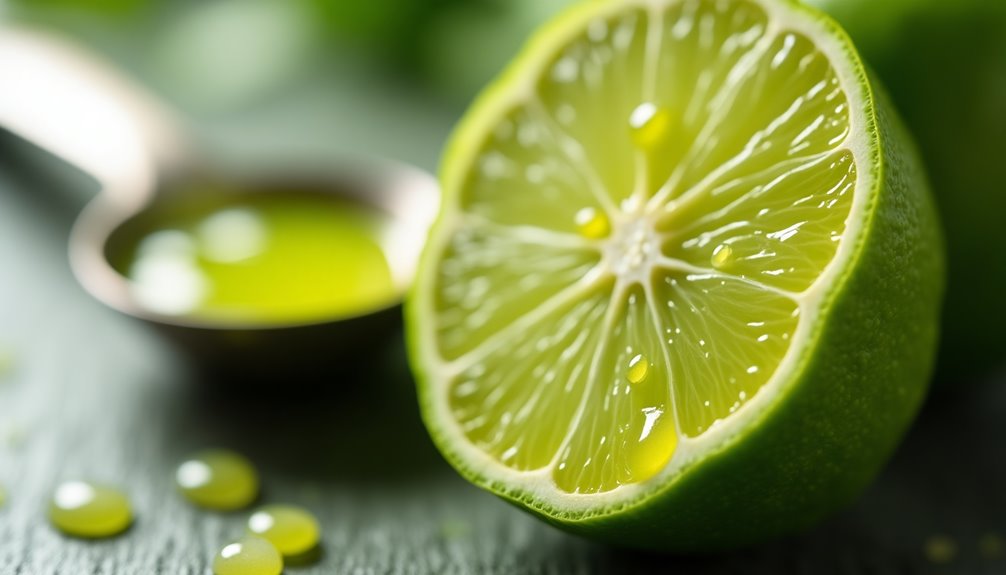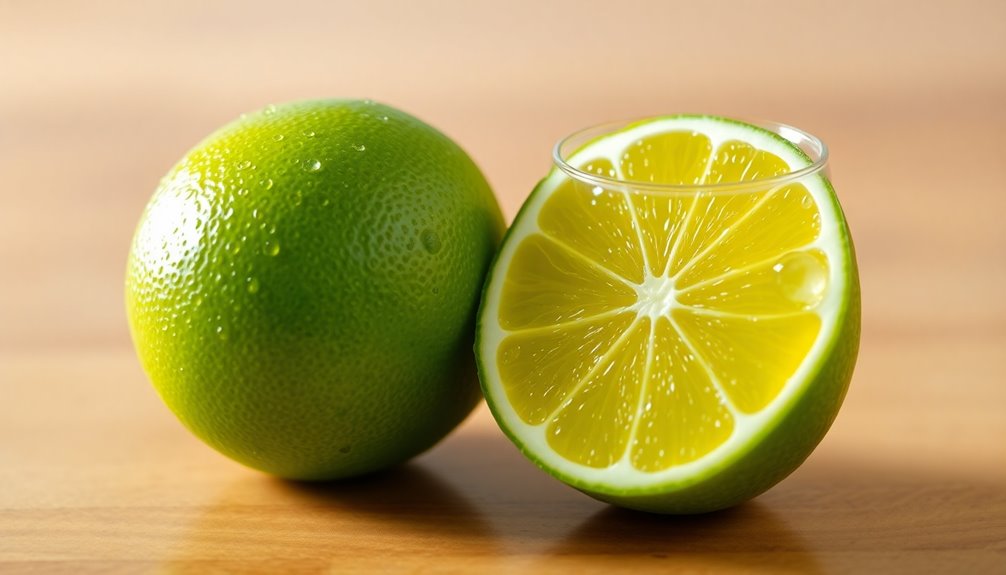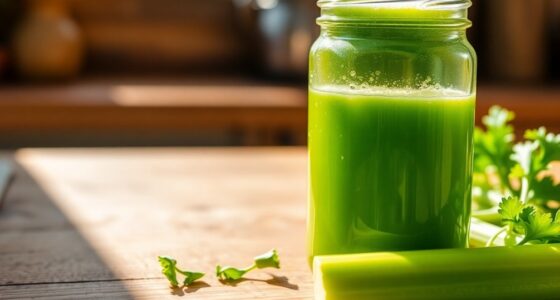A medium lime typically gives you about 2 tablespoons (1 ounce) of juice. If you only have a half lime, you can expect around 1 tablespoon (0.5 ounces) of juice. It's important to choose limes that feel heavy for their size, as they'll yield more juice. Fresh lime juice can really elevate your dishes, enhancing flavors like nothing else. If you're curious about juicing techniques or lime selection tips, there's more you can explore!
Key Takeaways
- A medium lime typically yields about 2 tablespoons (1 ounce) of juice.
- Half a lime produces approximately 1 tablespoon (0.5 ounces) of juice.
- Generally, 1/4 cup of lime juice requires around 2 medium limes.
- Fresh, ripe limes yield more juice than under or overripe ones.
- Always consider having extra limes on hand for recipe accuracy.

Have you ever wondered how much juice you can squeeze from a single lime? If you've got a medium lime on hand, you're in for a treat. Typically, it yields about 2 tablespoons (or 1 ounce) of fresh lime juice. This measurement can help you decide how many limes you'll need for that exciting recipe you want to try. Whether you're whipping up a zesty marinade or a refreshing cocktail, knowing your lime yield is key.
When you're ready to juice a lime, make sure you've got your cutting board out. Place the lime on the board and roll it under your palm for a few seconds. This little trick helps break down the internal membranes, making it easier to extract every last drop of juice. Once you've done that, grab a sharp knife and cut the lime in half. You'll notice how juicy and vibrant it looks, and you can practically taste that fresh lime juice just by looking at it.
Now, if you only need a small amount of lime juice, remember that a half lime usually produces about 1 tablespoon (0.5 ounces) of juice. This can come in handy if you're just adding a splash of citrus to your dish. But if your recipe calls for something more substantial, you may need to squeeze a couple of limes. For example, if you require 1/4 cup of lime juice, you'll need around 2 medium limes. It's always a good idea to have an extra lime or two on hand, just in case.
The yield of juice from a lime can vary slightly based on its size and ripeness. A perfectly ripe lime will give you the most juice, while an under or overripe lime mightn't yield as much. So when you're at the store, look for limes that feel heavy for their size. They tend to have more juice and a better vibrant flavor than those that feel light or look shriveled.
When you're preparing to juice a lime, think about how fresh lime juice enhances your dishes. It's often preferred over bottled alternatives because of its lively, bright flavor. Fresh lime juice can elevate a simple salsa or add a kick to your favorite drink, making it an essential ingredient in many recipes.
Frequently Asked Questions
How Much Juice Is in 2 Limes?
When you’re juicing two limes, you can expect to get about 4 tablespoons, or 2 ounces, of juice on average. To maximize the amount of juice you extract, roll the limes on a hard surface before cutting them in half. This technique helps to break down the internal membranes, making it easier to release the liquid. If you’re ever in doubt about how much juice in one lime, a good estimate is approximately 2 tablespoons, or 1 ounce, which can vary slightly depending on the lime’s size and ripeness.
Of course, the exact amount can vary depending on the size and ripeness of the limes you choose.
To get the most juice, try rolling them on a countertop before cutting.
Fresh limes usually offer a better flavor than bottled options, so it's worth the extra effort for your recipes.
How Much Real Lime Equals 1 Lime?
When you're trying to figure out how much real lime equals 1 lime, it depends on the size of the lime.
A medium lime usually gives you about 2 tablespoons of juice. If you're using a smaller lime, it might only yield around 1 tablespoon, while a larger one could provide up to 3 tablespoons.
How Much Juice Is in One Key Lime?
One key lime typically yields about 1 tablespoon, or 15 milliliters, of juice.
If you're using key limes for a recipe, keep in mind that they're smaller and pack a more intense flavor compared to regular limes.
You'll need around 20 key limes to get half a cup of juice, so if you're squeezing them, you might want to grab a few extra to ensure you have enough for your dish.
Can I Substitute Bottled Lime Juice for Fresh Lime Juice?
You can substitute bottled lime juice for fresh lime juice, but it's not always ideal.
Fresh lime juice packs a vibrant flavor that bottled juice often lacks due to pasteurization and preservatives. If you need to use bottled juice, aim for about 1 tablespoon for each lime's worth of juice.
Just remember, the acidity and overall taste might differ, so your dish or drink may not turn out quite the same.
Conclusion
In the end, while one lime might only yield about one to two tablespoons of juice, it can transform a dish from bland to bursting with flavor. Think of it this way: a small fruit holds the power to elevate a simple meal or cocktail, proving that sometimes, less is indeed more. So, the next time you squeeze that lime, remember—its modest size belies its incredible potential to brighten your palate and enhance your cooking.
Cindy thoroughly researches juicing trends, techniques, and recipes to provide readers with practical advice and inspiration. Her writing style is accessible, engaging, and designed to make complex concepts easy to understand. Cindy’s dedication to promoting the advantages of juicing shines through her work, empowering readers to make positive changes in their lives through the simple act of juicing.

















